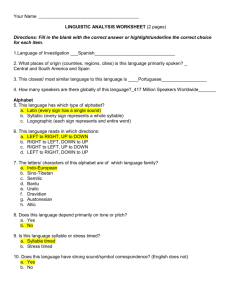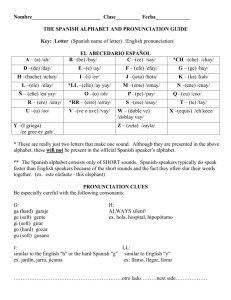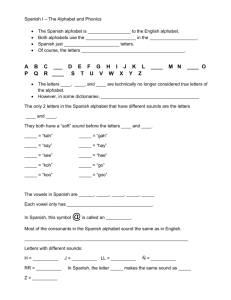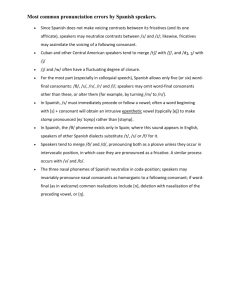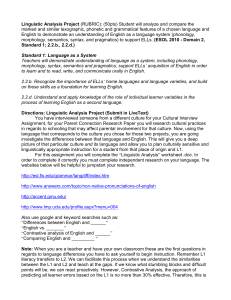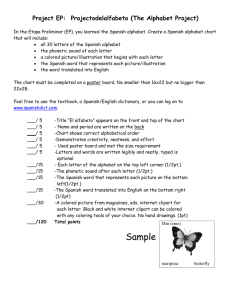Spanish
advertisement
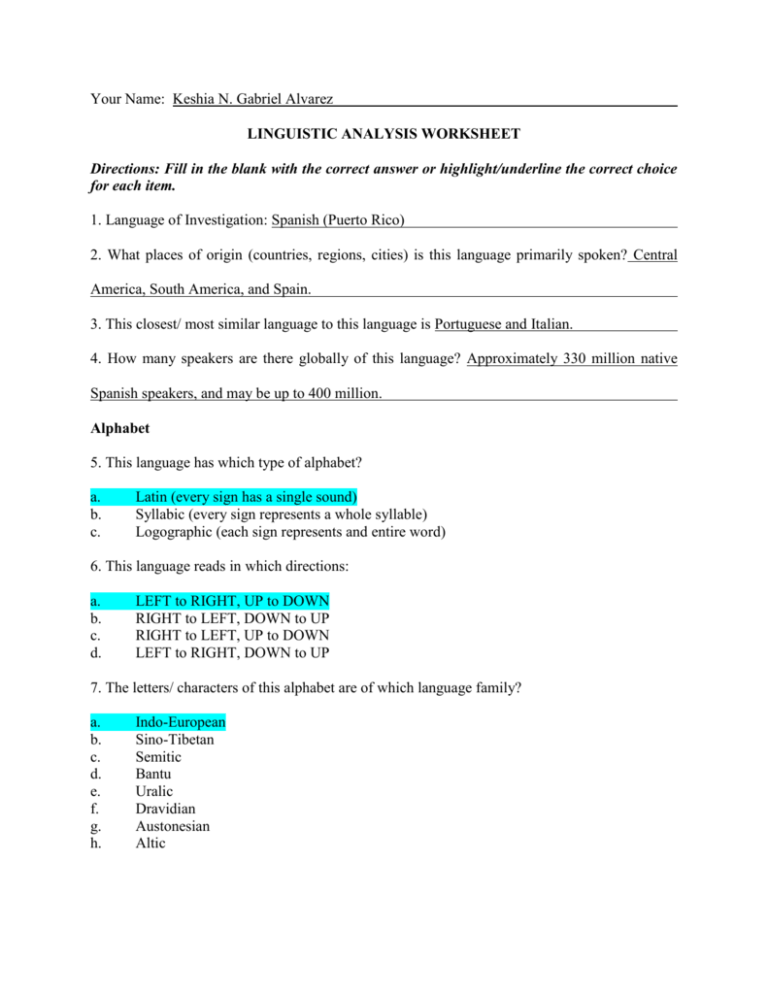
Your Name: Keshia N. Gabriel Alvarez LINGUISTIC ANALYSIS WORKSHEET Directions: Fill in the blank with the correct answer or highlight/underline the correct choice for each item. 1. Language of Investigation: Spanish (Puerto Rico) 2. What places of origin (countries, regions, cities) is this language primarily spoken? Central America, South America, and Spain. 3. This closest/ most similar language to this language is Portuguese and Italian. 4. How many speakers are there globally of this language? Approximately 330 million native Spanish speakers, and may be up to 400 million. Alphabet 5. This language has which type of alphabet? a. b. c. Latin (every sign has a single sound) Syllabic (every sign represents a whole syllable) Logographic (each sign represents and entire word) 6. This language reads in which directions: a. b. c. d. LEFT to RIGHT, UP to DOWN RIGHT to LEFT, DOWN to UP RIGHT to LEFT, UP to DOWN LEFT to RIGHT, DOWN to UP 7. The letters/ characters of this alphabet are of which language family? a. b. c. d. e. f. g. h. Indo-European Sino-Tibetan Semitic Bantu Uralic Dravidian Austonesian Altic 8. Does this language depend primarily on tone or pitch? a. b. Yes No 9. Is this language syllable or stress timed? a. b. Syllable timed Stress timed 10. Does this language have strong sound/symbol correspondence? (English does not) a. Yes b. No (http://www.sol-plus.net/plus/language/accents.htm) Directions: Complete this section ONLY if your language is Latin based (most languages you will encounter are). Phonetics and phonology 11. There are 5 vowels in this language. 12. They are (cut and paste the vowels in the actual script) a, e, i, o, u. 13. Which vowels sound the same as English vowel sounds? (list L1 vowel and English vowel correspondence). o, u. 14. Which vowel sounds do not exist in English? a, e, i. 15. There are 18 consonants in this language. 16. They are (cut and paste the consonants of the actual script) b, c, d, f, g, h, k, l, m, n, ñ, p, r, rr, s, t, w, y. 17. Which consonant sounds do NOT exist in English? g, k, ñ, r, rr, ll. 18. What sounds do speakers of this language have difficulty pronouncing? “Since Spanish does not make voicing contrasts between its fricatives (and its one affricate), speakers may neutralize contrasts between /s/ and /z/; likewise, fricatives may assimilate the voicing of a following consonant”. (http://www.answers.com/topic/non-native-pronunciations-of-english#Spanish) 19. Are there any sound placements that are different between English and this language? Yes 20. What are they? Ch (Spanish) and sh (English), v (Spanish) and b (English), s (Spanish) and z (English). 21. Do any double letter combinations exist in this language? Yes/Ch, ll, rr. 22. What are they and what do they correspond to in English? ll is y. Ch is sh. Syntax and Grammar 22. How many tenses exist in this language? 4 23. What are they? Present, future, past, conditional. 24. The word order of this language is a. b. c. d. e. f. Verb, subject, object (VSO) Subject, verb, object (SVO) (varies, not as strict as English) Object, verb, subject (OVS) Verb, object, subject (VOS) Subject, object, verb (SOV) Lacks a dominant word order 25. What are the punctuation forms used in this language? List using English comparisons. (¿) – different than English/used in front of a question. (?) same as English (¡)- different than English/used in front of an excitable sentence. (!) same as English (.) same as English. 26. How does this language mark gender? Spanish uses (a) for feminine words and (o) for masculine words Morphology 27. What are some shared cognates between English and this language? ENGLISH agency agony battery family history urgency remedy salary testimony dictionary active decisive festive effective indicative SPANISH agencia agonía batería familia historia urgencia remedio salario testimonio diccionario activo decisivo festivo efectivo indicativo 28. What are some FALSE cognates between English and this language? SPANISH ENGLISH Delito Despertar Fútbol Once Recordar Complexión Crime, not delight to wake up, not despair Soccer, not football Eleven, not once to remember, not record Physical build, not complexion 29. Through your research what have you found are the biggest difficulties of speakers of this language learning English? Please provide specific examples. I found a large contrast between pronunciations in each language. Spanish speaking students will have difficulty in this area. Also, spelling in English can be a difficult task as the English alphabet can not always be “sounded out”. Spanish words typically spell the way they sound; however, this is not the case in English. Spanish speaking students may sound monotone while speaking in English as their native language does not vary in tone as much as English. 30. If you have an early production ELL who this language is their L1, what would be the most important thing you will teach them in regards to the difference between their language and English? The most important thing I could teach them is proper pronunciation. When parents teach young children to speak we start with the speaking to them in our native language, and then assist children in learning the alphabet. If our ELL students can learn the proper pronunciation of the English alphabet they will have less difficulty in other areas of language/speech. The differences between feminine and masculine when comparing English to Spanish would also be a beneficial lesson. Also, perhaps showing them cognates will be beneficial so they will feel less alone in the learning process.
